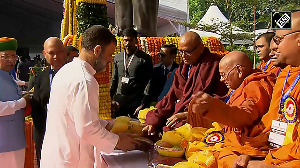The variety of available capital is mind-boggling: venture capitalists ready to throw their money at unproven concepts, private equity players ready to inject large dollops to grow businesses, buyout funds ready to recast ageing businesses, funds devoted to make private investments in publicly listed companies, mutual funds to support public offerings and hedge funds ready to gamble on any idea of any scale.
All of this capital is chasing the next Big Business Idea. Where do you go looking for it?
Where do these big ideas spring from? How do you recognise a big idea when you stumble on it?
Public imagination and the work of business journalists make big business ideas seem synonymous with big business personalities. In this recounting, Bill Gates is the titan who thought up the software packages that drive personal computing; Jamshedji Tata is the one who conjured up a steel plant in the wilderness of Bihar; India's software moguls dreamt up their vast outsourcing empires.
Yet, this recounting of business history may just be another version of what modern historians snigger at as the Great Man Theory of history, the attempt to explain history through individuals with great personal charisma and overpowering intellects. Thus the Great Man theory would examine the Second World War by focusing on the big personalities of the conflict: Churchill, Hitler, Mussolini, Franklin Delano Roosevelt and Stalin, and view the events of that war as arising from the actions of these Great Men.
An alternative view is that great new businesses are born when technological discontinuities occur. In this view, entrepreneurs, those Great Men, are mere midwives for the process.
For example, the advent of the personal computer would have created the need for software, and if not Gates, someone else would have fulfilled that need. Similarly, an expanding Indian railway system in the early 1900s created such demand for steel rails that if it was not the Tatas, someone else would have fulfilled it.
And the move in computing from the mainframe to the PC created such a need for armies of programmers to do the translation of software from the old mode to the new that large IT service companies in some part of the low-wage English-speaking world would have sprung up anyway.
The Russian economist Kondratieff, writing in the 1920s, took this kind of thinking to another level. He saw economies as moving in 50- to 60-year cycles with periods of high growth followed by periods of slower growth, with each cycle driven by a bunch of technical innovations.
Thus, wave theorists see five "Kondratieff waves" as having taken place in the modern era. The Industrial Revolution in the late 18th century was the first, followed by the Age of Steam and Railways (1830s), the Age of Steel, Electricity and Heavy Engineering (1870s), the Age of Oil, the Automobile and Mass Production (1900s) and finally, the Age of Information and Telecommunications (1970s). According to this theory, we are currently at the turning-point of the fifth Kondratieff wave.
The story of the Indian pharmaceutical industry spells out the processes by which the forces of a long wave are harnessed to achieve industrial leadership through policy interventions by government. In the 1950s, when synthetic drugs were all the rage, a German pharmaceutical product, Thalidomide, caused 10,000 children to be born with birth defects. As a strong reaction to this, the US authorities prescribed time-consuming and expensive clinical trials as a consumer protection measure.
The pharmaceutical industry reacted to this by demanding and receiving a stringent product patent system that would allow them sufficient time to recover their investments in proving the safety of drugs.
In India, a group of local pharmaceutical companies lobbied the Indian government to not subscribe to this product patent system - in their view patents should apply only to the process by which a drug is made and not to the product itself. During the long period of this regime, several large, Indian pharmaceutical companies got created by reverse engineering western pharmaceutical products and selling them in India.
If entrepreneurs are mere midwives, what make some better midwives than others and what make some business ideas more successful than others?
The auto industry provides some insights into this. The petrol engine-based motor car, a product of the Fourth Kondratieff wave saw, by 1910, several hundred car manufacturers all catering to the wealthy.
Using the mass production technique, Henry Ford decreased the price of his cars steadily as they improved in quality. The Ford car in 1904 had a two-cylinder motor, and sold for $1,200.
By 1924 it had a more powerful four-cylinder motor, and included a top and windshield; yet it sold for only $290. Not surprisingly, more than half of the cars sold in the United States in that period were Ford. The motor car was no longer a plaything of the wealthy.
This might then be the clue to look for. Hunt down the idea that makes lives of ordinary people better and you will find the Next Big Business Idea.
Ajit Balakrishnan is the founder and chief executive officer, rediff.com.
Comments welcome at ajitb.rediffiland.com
ALSO READ:
The last days of an IIM professor







 © 2025
© 2025